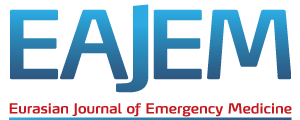ABSTRACT
Aim:
The aim of this study was to identify the clinical characteristics of patients with a diagnosis of non-ruptured aortic aneurysm (AA) fallowing the evaluation of their history and physical examination in the emergency department.
Methods:
The records of patients investigated retrospectively for a 12 months period who has the diagnosis of a non ruptured AA or aortic dissection (AD). The main complaints, vital signs, physical examination findings, ECG, chest xray, thorax and abdominal CT reports were recorded in addition to the demographics of the patients. In AD patients, the type of the dissection was noted in order to Stanford and De Bakey classifications.
Results:
Twenty-four patients were diagnosed with AA or AD in the study period. Sixteen (% 66.7) of the patients were man and 8 (33.3 % 7) were woman with a mean age of 50.6 years (r: 19-73). The most common presenting complaints chest pain (45.8 %, n=11), back pain (25%, n=6), syncope (12.5%, n=3), abdominal pulsation (8.3%, n=2) and abdominal tenderness (8.3%, n=2). The physical examination findings were cardiac murmur (33.3%, n=8), pulse deficit (20.8%, n=5), pulsatile mass (12.5 %, n=3), discrepancy of blood pressure in right and left extremity (12.5%, n=3), carotid murmur (12.5 %, n=3). AD was identified in 11 patient (45,8%), which was Stanford A in 9 (72,7 %) and Stanford B in 3 (27.3 %). For the De Bakey classification, 5 of the patients were in type I (45, 4%), 4 in type II (36, 3%) and 3 in type III a (18, 3 %).
Conclusion:
In patients presenting to emergency department with chest, back pain and syncope and who have cardiac murmur, pulse deficit and a pulsatile mass in physical examination, AA and AD must be considered in differential diagnosis in patients.



